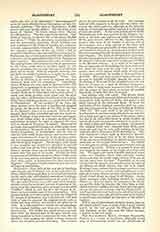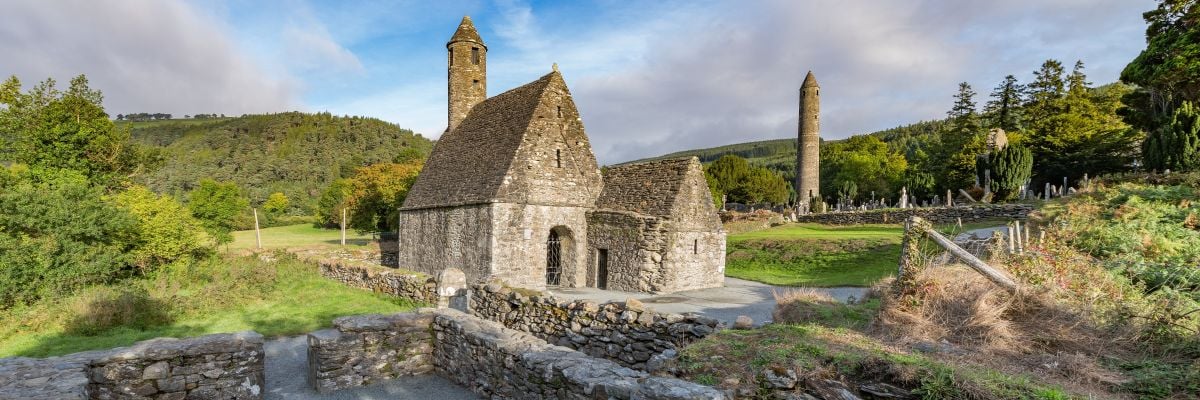

Glendalough, SCHOOL OF.—Glendalough (the Valley of the Two Lakes) is a picturesque and lonely glen in the heart of’ the Wicklow Mountains. The fame of its monastic school is chiefly due to its founder, St. Kevin (q.v.), and to Laurence O’Toole, the last of the canonized saints of Ireland. Kevin (Ir. Coemghen, the fair-begotten) was born near Rathdrum towards the close of the fifth century, and lived to the age of 120 years. His earliest tutor was St. Petroc of Cornwall, who had come to Leinster about 492, and devoted himself with considerable ardor to the study of the Sacred Scriptures, in which his pupil also became proficient. Kevin next studied under his uncle, St. Eugenius, afterwards Bishop of Ardstraw, who at that time lived at Kilnamanagh in Wicklow, where he taught his pupils all the sacred learning which he had acquired in the famous British monastery of Rosnat.
Young Kevin was at this time a handsome youth, and had unconsciously won the affections of a beautiful maiden, who once followed him to the woods. The young saint perceiving her threw himself into a bed of nettles, and then gathering a handful scourged the maiden with the burning weeds. “The fire without”, says the biographer, “extinguished the fire within”, and Kathleen repenting became a saint. There is no foundation for the story, which Moore has wedded to immortal verse that Kevin flung the unhappy Kathleen from his cave, in the face of Lugduff, into the depths of the lake below. Kevin then retired into the wilds of the Glendalough valley, where he spent many years in a narrow cave, living alone with God in the practice of extreme asceticism. In the course of time, holy men gathered round him, and induced him to build the monastery, whose ruins still remain lower down in the more open valley to the east. Here his fame as a saint and scholar attracted crowds of disciples, so that Glendalough became for the east of Ireland what the Arran Islands were for the west—a great school of sacred learning, and a novitiate in which the young saints and clergy were trained in virtue and self-denial.
One of the most celebrated of the pupils of St. Kevin at Glendalough was St. Moling, the founder of the well-known monastery, called from him St. Mullins, on the left bank of the Barrow in the southwest of the County Carlow. Like his master Kevin, he was a man of learning and extreme austerity, living, it is said, for a long time, as Kevin did, in a hollow tree. He was also an elegant writer both in Latin and in Irish. Several Irish poems have been attributed to him, his prophecies were in wide circulation, and the “Yellow Book of St. Moling” was one of those which Keating had in his hands, but which has since been unfortunately lost. Of all the scholars of Glendalough, however, St. Laurence O’Toole was by far the most distinguished. A great scholar, bishop, patriot, and saint, he owed his entire training in virtue and in learning to this school. So far did he carry his devotion to St. Kevin that, even after he had become Archbishop of Dublin, he made it a practice to retire from the city, and spend the whole Lent in the very cave in the face of the rock over the lake where St. Kevin had lived so long alone with God.
The existing ruins at Glendalough still form a very striking scene in that wildly beautiful mountain valley. Within the area of the original enclosure are the great church, or cathedral, built probably in the time of St. Kevin, a fine round tower still 110 feet in height, the building called St. Kevin’s Cro or kitchen, and the Church of the Blessed Virgin: for whom Kevin, like most of the Irish saints, had a particular devotion_ The building called St. Kevin’s kitchen was doubtless the private oratory and sleeping-chamber of the saint, the latter being in the croft overhead, as in St. Columba’s house at Kells.
JOHN HEALY


